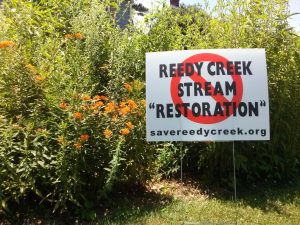Reedy Creek has become a source of severe contention between citizens and politicians in the city of Richmond. This little creek, a minor tributary to the mighty James River, plays a central role in a movement that has spread lawn signs to probably at least eighty percent of houses in the communities within the Reedy Creek watershed. Before visiting Reedy Creek myself to see the source of all this controversy, I could not understand why plans to restore the creek to improve the natural environment in Richmond caused so much backlash. I thought that everyone should be able to get behind any plans to help the environment. However, after seeing the site of the proposed restoration, as well as other areas around the creek that would be affected by the plans, and then also hearing about the cities handling of the project, the cause for controversy became very clear to me.
I did not have to look at a map to know when we were getting close to Reedy Creek. The hundreds of yard signs lining the road proclaiming “Stop Reedy Creek!” told me that the creek must be nearby. Sure enough, we soon arrived and walked through the woods of Crooked Branch Park towards the creek. Our guide began our tour of Reedy Creek by telling us that these
woods, hidden away behind a neighborhood of houses, was actually in very good condition for an urban forest. However, the restoration of Reedy Creek would take a fair portion of these woods. This was my first hint that I was about to hear about a lot of problem with the planned restoration. My expectations were not disappointed. As the tour progressed I heard about how the creek isn’t actually in very bad condition, how their is no plan to maintain the restored creek so that it does not simply end up like a similar restoration project at Albro Creek, and how the city’s motivation to do the project is all wrong. These last two problems were especially concerning to me. First, the city expected that local community members would simply take care of the creek without even consulting with them first, which shows how unconnected the city is to the local community. Second, the city seems to be only doing the project to get environmental protection points, not because they see a problem that they want to fix in order to protect the environment. These two problems are very connected because if everyone on the city council came down to thee creek and took the tour that myself ad my class did, they would probably throw out the entire plan.
After seeing Reedy Creek and the nearby communities, I saw that the local community does care a lot about the creek, and also know a lot about what it actually needs. If restoration really was the right path forward, chances are members of the community would be willing to maintain the creek. However, rather than just assuming that everyone will help out, the city should have spoken to them. They would have heard how going after the sources, such as storm water run-off and pollution, works better than going after symptoms through restoration. Rather than engaging the community in maintenance, the city should engage the community by encouraging people to purchase rain barrels and turn impervious surfaces in rain gardens. A tour of Reedy Creek would also solve the second problem of doing restoration for the wrong reasons. It would show the city that restoring Reedy Creek could actually do more harm than good even if they still get their points. A generic point system does not always hold true for all environments, so while stream restoration may do a lot of good somewhere (Such as the Gambles Mill Corridor), it could also cause a lot of harm somewhere else, like in the case of Reedy Creek.
When it comes to healing a sick environment, passing down orders from city hall will never work. One has to see the environment, and hear from the people who spend time in that environment, to understand how to best help. Reedy Creek and the surrounding watershed do need help, but not through restoration. And while other forms environmental protection might not gain as many points as stream restoration, they will do so much more to actually help Reedy Creek, and that’s what we all want anyway, isn’t it?



It’s an excellent argument for venturing out to experience an issue that would otherwise be abstract. When I first graduated from college, I worked for an environmental consulting firm in Boston. One of my first cases was assessing the damages to loon populations from an oil spill in Rhode Island and proposing possible restoration projects. After working on the project for a couple months, I was staying with some friends at a cabin up in Maine, and I heard this crazy call one night. Turns out that was a loon, and it occurred to me that I had never seen one before. That trip completly changed how I thought about the challenge of restoring these birds. Just changed my perspective and how I thought about the problem entirely. I hope you have many experiences like this in you lifetime and are open to them when they come.